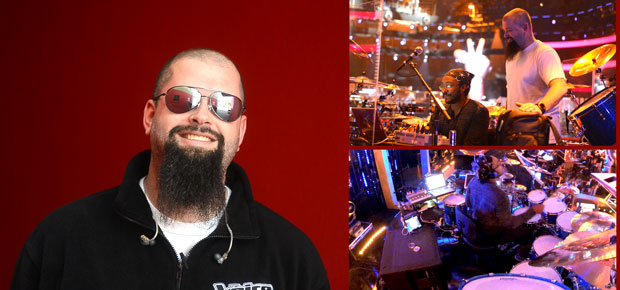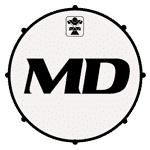<em>The Voice</em> Drummer and June 2014 <em>Modern Drummer</em> Cover Artist Nate Morton Interviews Drum Tech Steve “Steevo??? Morrison

Nate: How did we meet?
Steevo: You and I met the summer of 2006, on the TV set of Rockstar: Supernova while I was still working with Tommy Lee. You were in the house band and like everyone else that saw you for the first time your playing and showmanship blew me away. I offered to change a snare head and that started our friendship.
Nate: Exactly how many drumkits are in rotation at any given time on The Voice and what comprises their regular maintenance?
Steevo: At a minimum we have three kits in rotation during the bulk of the season, with the live rounds bringing that total up to nine kits some weeks. Heads are changed everytime we record, be it in the recording studio or on the soundstage. Cymbals are cleaned daily, as well as all the chrome and the shells. They need to sound great and look amazing—simple as that.
Nate: Do you have any tricks of the trade you’d like to share?
Steevo: My tricks of the trade are a few drummer-specific products that I cannot live without. The Gibraltar WingKey is a great invention, and the incorporation of the wing-nut tightener is brilliant, especially with how hard you hit. For tuning, I use a bunch of different methods, depending on time constraints and engineer requirements, but my trusty Dewalt drill (with key bit) and Drum Dial are my go-to on the live stage and in the studio. The Drum Dial gives me absolute precision for TV, so I can give Randy (our music mixer in the truck) the exact same notes every time we do a head change without having to make a ton of noise and bother our producers. It gives me the freedom to tune when it is not possible to hear the drum. Another tuning device, the TruTuner, is fantastic for super-speedy head changes. For cymbals, Groove Juice is always best when I have the time to take them off the kit. They end up looking amazing. However, for daily spot-treatments, any decent spray cleaner, like those by MusicNomad or Dunlop, gets thumbprints and stick wax off. Advertisement
Nate: Can you compare/contrast what it’s like setting up and breaking down one kit four or five times per week as opposed to setting up and tearing down nine different kits in a weekend?
Steevo: The craziness during the live rounds, when you’re playing a large number of kits, varies greatly from touring in the fact that you play each drumkit for one three-minute song, are each chained to the riser (one of which is on a 10-foot riser!), and they need to be immediately torn down following their use. One of our audio techs said it best: “It’s like an awards show every night.” The fun of that over a touring rig is we get to come up with fun setups that are different for each song every week. It’s a blast for me.
Nate: During the live shows, when everything is happening in real-time, what is the biggest crisis you had to deal with?
Steevo: Oh, this is a good one! About ten minutes before we go live to air for Season 3’s live rounds, I go to tighten the screws on the butt plate and one strips out completely, rendering the snares useless. I ran to our key grip James, and he came back with a screw that was just slightly larger in thread. We forced it into the metal of the butt plate. It held, and we made it happen by the downbeat of the first song heard live by fourteen million people. That was kind of stressful.
Nate: Complete this sentence: “The thing I find the most rewarding about my job is…”
Steevo: The thing I find the most rewarding about my job is I get paid to do what I love. What is more rewarding than that? But seriously, the most rewarding part of my job is seeing and hearing you every week on NBC and knowing I had a part in making you sound your best. Advertisement
Nate: Complete this sentence: “The thing I find the most challenging about my job is…”
Steevo: The thing I find the most challenging about my job is tuning in the recording studio. I feel like an amoeba in a Petri dish. The mics are the microscope, and the engineer is the scientist. You hear everything that is going on in a drum under close mics, and it keeps me on my toes.
Nate: What inspired you to begin building snares? And do you have any plans to eventually begin building entire drumsets?
Steevo: When you requested an acrylic kit, Brian Dong built the toms and kick and showed me the process. I did the snare for that kit, and then one for the main live kit. That is what started it all. At the moment, I love concentrating on snare drums and getting them out to drummers who love to play unique instruments that no one else has. There is no doubt in my mind that we will start building kits at some point in the future.
Nate: How important is it to you to have a knowledge of electronic drums and/or programming?
Steevo: I feel it is very important to have at least a grasp of all the current e-drum technology out there, and basic DAW skills are a huge plus when a lot of bands are using triggers, playback systems, or both. Some groups even run time code to the lighting and video systems. It’s nuts! My advice is to learn as much as you can. Advertisement
Nate: Thanks, Steevo. You’re a great interview and a terrific drum tech. I’m fortunate to have you! Anything else you’d like to share in closing?
Steevo: I would just add that for twenty years I’ve lived by something a drumming influence once told me. He said, “Patience and practice are the elements of success.”
Pick up the June 2014 issue of Modern Drummer magazine now!


